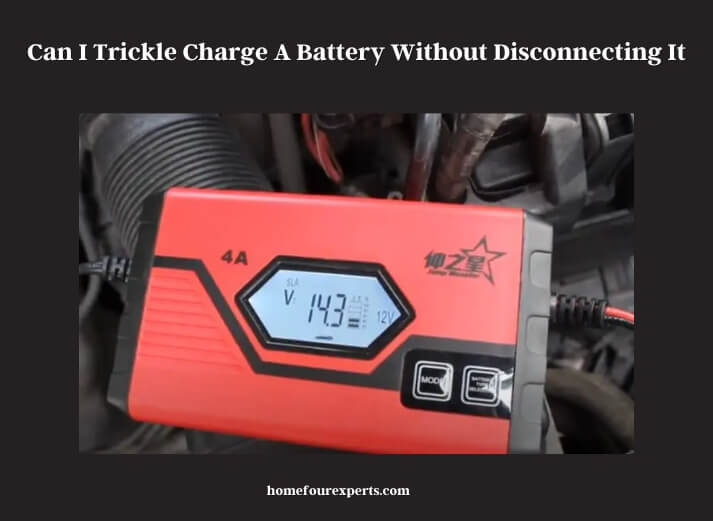A trickle charger might be an excellent investment, especially if you’re considering a backup power source for your battery. If you’re new to battery management, the query “Can I trickle charge a battery without disconnecting it?” is a perfectly reasonable one. Charging a car battery while connected is absolutely safe if you take precautions.

You don’t need to unplug the battery when using a conditioning trickle charger. Previously older chargers without a microprocessor delivered extremely high charging currents, which quickly harmed electrical components. But it is entirely safe by the grace of microprocessor-controlled modern trickle chargers, which supply low current.
Trickle chargers keep automotive batteries from running out of charge. The low-voltage control is designed to promote battery health over the time with less risk of overcharging.
When charging, you can leave your battery connected if you’re using a trickle charger designed to retain your battery at a specific amount of charge for lengthy periods. To find out the process of using a trickle charger with a connected battery and whether it’s safe, we suggest going through this writing.
What Is a Trickle Charger?
Typically, a trickle charger is a car battery charger intended to be left on a car for an extended period to recharge the battery. It steadily adds charge to the battery, preventing it from experiencing the periodical reduction of charge that batteries commonly experience. There are diverse viewpoints on- how long can a trickle charger be left on a battery? Mostly it depends on the types of trickle chargers.
Some trickle chargers are capable of being left connected to a battery for an unlimited period. These would be utilized on a vehicle that is not used regularly or stored for the winter or the summer months. If the vehicle is required in an emergency or other unplanned situation, a trickle charger designed expressly for this purpose is left on overnight. It prevents the battery from becoming exhausted due to inactivity.
Step by Step Process of Using a Trickle Charger With a Connected Battery
It is straightforward to use a trickle charger. The majority of trickle chargers are comprised of a small box that contains the “heads” of the charger, a power wire, and two alligator clips. Before attaching anything, make sure the voltage and amperage are adjusted to the appropriate values for your battery. Follow the below steps to charge your vehicle’s battery at a pace throughout the day.
Step-1: Make Sure the Battery Is Ready to Be Charged
Remember that if there is too much hydrogen in a confined location, it might build up and cause an explosion or blazing. So, make sure that the car is parked in a well-ventilated but covered place. Additionally, turn the ignition off and remove the key.
Step-2: Select an Appropriate Ground Location.
The following step is to locate a suitable place for the trickle charger’s negative connection. There should be a huge bolt on the engine block or chassis. You’ll discover a portion of the frame that is free of grime, dirt, and grease. Bear in mind that you should never connect a battery’s negative terminal to anything. Otherwise, you risk inflaming an explosion or starting a fire.
Step-3: Connect the Cables
Connect the red alligator clip to the battery’s positive terminal. Then attach the black negative wire to the ground point determined in Step 2. Avoid touching the charger’s cables while it’s attached. If you don’t, you could experience a life-threatening shock or be injured severely.
Step-4: Turn on the Charger
After connecting the connections, consult your battery’s documentation to determine the charger’s optimum settings. Now, connect your charger and turn it on.
Step 5: Check the Information on the display
At the end of the process, make sure the device is charging correctly by checking the display. Many battery chargers are equipped with an amp meter, which will read lower to zero on a fully charged battery and higher on a fully discharged battery. Keep the battery attached until fully charged.
After charging the battery, turn off the mains power and disconnect the terminals. This eliminates the possibility of sparks igniting any released hydrogen vapours.
The Advantages of Using a Trickle Charger
Individuals can save money by using trickle chargers. It can even save users the time and effort associated with recharging batteries after being kept for an extended period. Additionally, the following are some advantages:
Extended Battery Life:
A significant benefit of trickle chargers is their ability to safely charge a battery for an extended period without causing damage. Most systems incorporate automatic cycles that shut off the charger when the battery reaches its maximum capacity and restart it when the battery level falls.
Battery Recharging:
When batteries are left unused for an extended period, they lose their capacity. Using trickle chargers helps keep a vehicle’s battery charged even if the vehicle has been sitting for a while. When a battery is attached to the charger, it transfers power in a slow, steady trickle, helping to extend the battery’s life.
Prevent Battery Failure:
A trickle charger protects your battery from sulfation, which frequently occurs when a battery is discharged for an extended period of time. Sulphide destroys batteries and renders them inoperable if an excessive amount accumulates inside the battery.
How Long Does It Take a Trickle Charger to Charge a Car Battery?
A 2 amp trickle charger will take a long time to charge your 12-volt car battery. Charge time varies based on the battery’s degree of drain when charging begins. Trickle chargers are used to keep your battery charged over time, so you are never left stranded with a dead battery. It needs a prolonged time to charge, and some chargers turn off automatically when the battery is full.
Usually, the common query of “Do I need to disconnect the battery to use a trickle charger?“ is already answered. Trickle chargers are often used in workshops to maintain batteries while the technician works on the automobile, mainly if the battery is separated for an extended period. This assures the battery has enough charge to start the automobile when the car is reconnected.
What Type of Trickle Charger Do I Need?
Your trickle charger must have a higher amp-hour value than your car’s battery if you want it to work. For optimum performance, a trickle charger should have an ampere rate of fewer than five amps, and a rapid charger should have an ampere rate of more than 10. In general, it takes a car’s battery 20 hours to deplete from 100% charge.
If you’re using a larger battery, it may take longer. Ten to fifteen hours after a full charge, connect the trickle charger. If you’re going to leave your automobile unattended for several weeks or months, turn on the trickle charger first. When the battery runs out, it will replenish itself automatically.
Conclusion
We hope all your doubts about “Can I trickle charge a battery without disconnecting it?“ are now clear through this article. After discovering the benefits and practices of using a trickle charger, you are now more confident to go.
A trickling charger charges the battery more slowly than a rapid jump start. While leaving something connected to your battery for an extended amount of time may seem unusual, these devices are designed to be used in this manner.
However, specific trickle chargers may be safely left connected for months without causing damage to your battery, making them an ideal method for long-term battery management. Others may be linked for little more than a few days. It’s a great idea to check with the manufacturer to determine how long their items should be left on.
See also:
About This Writer

Hi, I am responsible for the 'Homeowners Power Solutions' category. My name is Liam Jaxon and a licensed technician with 7 years of experience in vehicle batteries, electrical gadgets, and home appliances. My working experience in different residential & light commercial electrical sectors and the automobile industry helped to acquire vast knowledge in this industry.